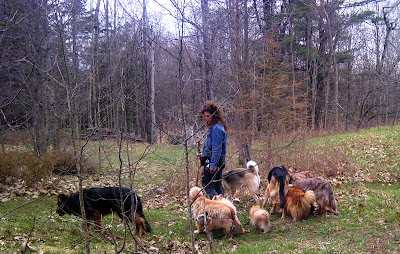IS YOUR DOG ANXIOUS OVER EXCITED IN THE CAR?
PANTING,
WHINING, BARKING, NOT SETTLING DOWN… if the experience of going
for a drive in the car with your dog has become stressful for you and your dog
it’s time to address the situation. Left as is, neither you nor your dog can
relax, normalize and enjoy the time spent together.
To cure the behavior you must address and correct the root cause - this
is a psychological issue – your dog’s and yours. Rescue remedies may help but
they are unlikely to cure the behaviour.
Here are a few examples of how we de-normalize the situation for our dogs
and create the behavior problem…
One - If you make a fuss when you are about to go out to the car, you ‘wind’
your dog-up and teach your dog that leaving and going out in the car is
associated with excitement… i.e. ‘hey boy, you want to go for a ride in the
car!’ by creating intense excitement you are destabilizing your dog’s state of
being. You are overwhelming and flooding their senses. You are telling your dog
to be excited, you are enabling an altered state. For an insecure dog this can
trigger anxiety and anxiousness.
Two - If, in the past you or your dog has experienced a traumatic incident in
the car and you still carry some of that stress from your traumatic experience
your dog can sense your disquiet, nervousness, upset.
Three - You may have been upset or very excited when you first brought
your dog home in the car.
Four - Your dog has motion sickness. When your dog gets sick in the car you
get worried, frustrated, angry or otherwise stressed. For guidance on curing
motion sickness in your dog you can read this article.
Now let’s talk about
curing this behavior
STEP ONE - CHANGE
YOUR OWN BEHAVIOR
I usually spend the first 30 minutes to 60 minutes of a four hour session
just dealing with the human's issues - which trigger the dog's issues. When we
humans start to accumulate nervousness pertaining to our dogs in certain
situations (i.e. Our dog going up to another dog) we teach them to associate
that situation with tension, nervousness, fear, insecurity, excitement...this
is why dogs become reactive. Our dogs read our body language as our thoughts
translate directly and instantaneously to our bodies. The second you feel
tension, your body shows it...compression of your lips, tension around your
eyes, your shoulders - your dog knows how you feel before you are aware of how
you feel! You must relax and normalize so your dog can too.
To understand more about how you can inadvertently communicate the wrong
message to your dog and to understand more about how to communicate the right
message you can read these articles:
To learn about HSD - Heightened Sensitivity Dogs
Dogs are More Sensitive than Most People Realize
Mindfulness Exercise - Breathing is Communication
Because dogs live in the moment it is easier to change a dog's 'bad
habits' than it is a human's. Humans carry grudges, dogs do not. Dogs form
associations with places, things, animate and inanimate objects. Dogs are very
forgiving and treat each day, each experience as a new beginning. It is only
with difficulty that we are able to convince, permit and allow ourselves to do
the same.
Make the future different than the past. You must let the past go - must
not anticipate that the past will and must repeat itself - let it go from your
mind. Envision a new future in which you forget about what has happened before
and focus instead on what you would like to happen - a nice peaceful ride in
the car with your dog.
When you change your thoughts from negative to positive you relax - this
allows your dog to do the same. You are leading by the right example.
STEP TWO - SET THE
FRAMEWORK AND GET READY TO GO OUT
You then have to set the framework for the car ride before you get into
the car! How you go out of the house with your dog matters! You must have
control of your own state of being and your dog at every step of the way. This
sets the framework for good behavior in the car.
A - When you want your dog to go to the front door to get ready to go,
call your dog over in a calm, confident manner. Don’t wind your dog-up. Don’t
say, ‘we’re going out’ or ‘do you want to go for a ride’ - you do not need to
say anything at all - your dog already knows. Don’t engage your emotions, just
be matter of fact - remember this should be a normal event.
B - Your dog needs to be, calm and quiet before you walk out the door, if
you are attaching a leash to go out to the car your dog needs to be calm and
quite before you attach the leash to your dog’s collar.
C - When you are ready to approach the door, stand-up straight - your
posture should be upright, confident, not tense - be aware of your shoulders,
arms and how you hold the leash in your hands. If you are gripping the leash
with tension, if your arms and shoulders are stiff with apprehension and
tension you are giving your dog a message - you are communicating that you are
not in control of yourself and therefore you cannot be in a leadership position
with your dog. You are enabling stress, anxiety, insecurity in your dog.
D - Your dog is behind you before you open the door;
E - Your dog is to stay behind you as you walk out the door (and down the
steps);
F - Your dog is either behind or beside you to the garage or across the
lawn (pathway) and out to the sidewalk and to the car.
If you or your dog is
not calm - stop.
I see so many people keep moving forward when their dog is not calm, when
they (the person) are not calm. Stop, get your dog calm and then continue
moving. If your dog is reacting and you keep walking you are telling your dog
it’s OK to behave as you are. Stop regain control and then move forward.
It matters 100% what
state you and your dog is in before you get into the car!
Don’t engage in an argument with your dog and don't whine! Don't say to your dog ' oh, I wish you wouldn't do that'...to do so is whining and complaining, not directing - provide leadership, coach and mentor your dog. If you expect
trouble you will get trouble…your dog can feel if you are anticipating an
argument, instead remember to think i direct, my dog listens and that is it! Be
100% committed - your dog knows when you are not. Your dog knows when he has an
edge to manipulate and control. Be fair, but be determined.
Tugging and pulling, yelling - it’s all an argument. This is a
psychological test of wills - make sure your will is greater and comes from a
place of confidence and strength of commitment.
Remember your dog has probably been doing this for awhile (as have you!),
so have patience and persistence. Adjust your expectations too. When we are
tired or stressed we don’t have the same focus, patience and control as we do
when we are relaxed and refreshed. Some days are better than others – never
give-up hope. Persist…change can take a little time. It takes time to train
yourself to lead, communicate and direct effectively and we all have good days
and bad days!
If your dog starts to get excited you must be the polar opposite – calm
and directive. Don’t get sucked into the vortex of your dog’s emotion,
disengage your emotions engage your working mind.
And remember if you
need to disagree with any excited behaviour…
One - Make sure you are calm (without excess emotion) and ready to coach with
fair, firm confidence. Don't be aggressive; don't raise your voice in anger.
Two - Lead...addressing from a distance is not leadership! Calmly but with
assurance go over to your dog. If you need to move a distance - fine, move
quickly, deliberately, confidently - not panicked or excited! Don't match your
dog's state, if you do so, you lead by the wrong example.
Three - get your dog's attention, you can touch your dog firmly but quickly
with your fingers - at its neck or waist, you can snap your fingers and say
'hey' or ‘shh’ firmly, but not with anger. Never touch or talk in anger as you
then lead by the wrong example!
Four - tell your dog what you want i.e. 'shh’
Five - tell your dog what you would like it to do instead i.e. 'Relax or
‘calm’' etc.
Six – what until they are calm to move forward.
STEP THREE - GETTING
INTO THE CAR
One – when you stand beside the car your dog must be calm;
Two – when you open the car door,
your dog must be calm;
Three – you must wait until your dog is
calm before you invite your dog into the car. When your dog is calm invite it
to get into the car…or if the dog is small, you can then pick your dog up and
put it in the car;
Four – if your dog runs about in the
car you should get it a harness and seat belt tether…or crate your dog. Your
dog must learn that it cannot pace or dash about in the car.
Five – as long as your dog has gotten
into the car in a relaxed state and you remain positive and relaxed in the car
you should see your dog’s behavior
start to change, become more relaxed.
Six – you can also use rescue
remedies or flower essences in
combination with the methodology above.
Lastly, be patient and persistent, many people give-in and give-up too soon.
Your ability to affect change in your dog is dependent on your leadership skills and your awareness of how you and communicate. As your skill grows, your ability to affect change will too.
Holistic Diet, Nutrition, Wellness Services Tailored to Your Individual Dog and Cat
For information about my holistic diet, nutrition and wellness services, visit my holistic wellness services page.
Maintain good health | Address acute and chronic health issues | Pre and post surgery support and recovery
My holistic wellness services are available worldwide via video consultation.
🌎 USA | Canada | UK | Europe | Australia | New Zealand | Asia | South and Central America | Africa | UAE
📱FaceTime | Facebook | Skype | WhatsApp
To set-up your holistic wellness consultation get in-touch via email, go to my contact me page.
Holistic Behavioral Services for Your Dog
For information about my holistic behavioral services, visit my holistic behavioral services page.
For dogs of all ages, sizes and breeds.
My behavioral services are available worldwide via video consultation.
🌎 USA | Canada | UK | Europe | Australia | New Zealand | Asia | South and Central America | Africa | UAE
📱FaceTime | Facebook | Skype | WhatsApp
To set-up your holistic behavioral session get in-touch via email, go to my contact me page.
Affiliations to Companies
✓ None.
✓ I don't sell food, supplements, or other products.
✓ I'm not aligned with any companies.
Article and graphics by Karen Rosenfeld.













